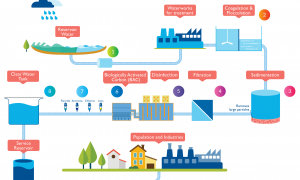🕑 Reading time: 1 minute
Tide gauge is an instrument used to measure the changes in water level with respect to a vertical datum. The variations in sea level during high tides and low tides are measured by using tide gauge. It is mainly used for hydrographic surveying purposes. It is also called as marigraph or sea-level recorder.
Contents:
Types of Tide Gauges
Tide gauges are classified into two main types as follows :
- Non-recording type tide gauges
- Recording type tide gauges
Non-recording type tide gauges
Non-recording type tide gauges are those which require an observer to note down the readings from time to time. Non-recording gauges are classified into three types as follows :
- Staff gauge
- Weight gauge
- Float gauge
1. Staff gauge
Staff gauge is a simple type of tide gauge used to measure the water level. It contains a graduated vertical board having width 150 to 250 mm and thickness of 100 mm. Staff gauges of different heights are available and suitable height is selected based on different conditions. The height markings are graduated to a least count of 5 to 10 cm.
Staff gauge is positioned vertically at a point whose elevation is already known. If it is unknown, it should be measured by leveling. The variations in water level are noted manually by seeing the staff directly from some distance.

2. Float gauge
Float gauge is another type of tide gauge which contains a long wooden box of 300 mm x 300 mm square section. A float attached with graduated vertical rod is arranged inside the box. A series of holes are provided at the bottom of the box and through these holes, the water enters into the box and lifts the float. The readings are noted by seeing the graduated rod through slit window.
Float gauge is preferred over normal staff gauge since it is easy to read the float gauge than staff gauge during the high intensity of tides in the sea or when there are more variations in water level.

3. Weight gauge
The weight gauges are of two types namely chain gauge and wire gauge. Chain gauge consists of a horizontal graduated scale and a chain attached with weight. The chain is arranged alongside the graduated scale and passes over a pulley. The gauge is mounted on a support of known elevation and the weight is lowered until it touches the water surface. Now the reading is observed on a graduated scale with respect to the index mark provided on the chain.

Wire gauge, another type of weight gauge in which cable or wire wounded to a graduated reel is used instead of chain and graduated scale. In this case, a pulley is also provided for the movement of the wire. The reading is observed from the graduated reel.

Recording Type Tide Gauges
Recording type tide gauges record the variation of water level automatically from time to time. Hence these are also called as self-registering tide gauges. There are various types of recording tide gauges available. However, most of them contain similar components.
Recording type gauge consists of a float attached to a wire which passes over a wheel. The wire is maintained at a constant tension by the means of a counter-weight or some suitable arrangement. The float is protected from wind or wave actions.

Whenever there is a change in water level, the float displaces and this movement is transferred to wheel. The wheel reduces the scale of reading by some gear system and finally conveyed to a pencil which traces a curve on graph paper which is wound around a rotating drum. The drum rotates at a constant speed and generally, the speed is about 1 revolution per day.



